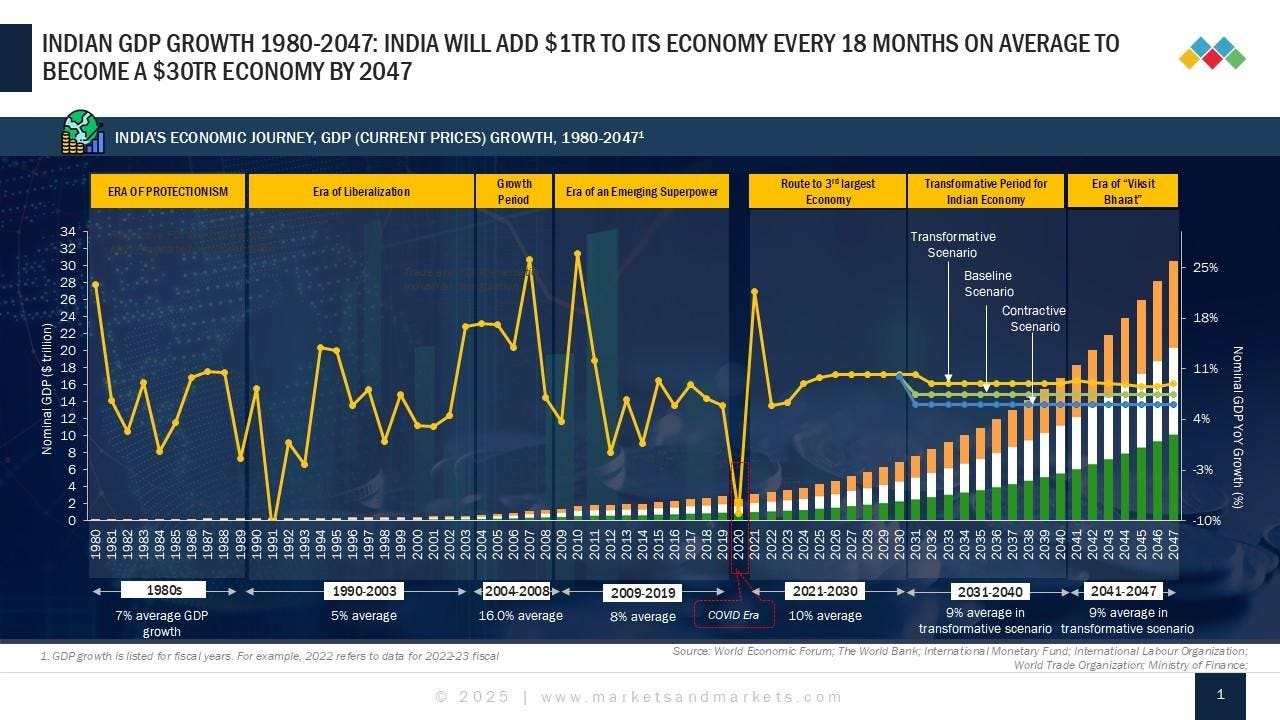They say Indian economy is like the Elephant, it takes a while to get going but once it runs, it could be unstoppable.
India is already on the path to economic greatness, having surpassed Japan recently to become the 4th largest economy in 2025. And that’s just the beginning! By 2028, India is also expected to become the world’s third-largest economy, moving ahead of Germany. India is aiming to add about USD 1 trillion to its GDP every 12 to 18 months over the next decade, targeting a CAGR of 9% nominal GDP growth rate from 2025 to 2047. While this is undoubtedly ambitious, India’s strong macroeconomic fundamentals, demographic advantages, urbanization, growing capital market, and focus on structural reforms are some of the main drivers that provide a solid foundation for sustainable growth. My Foresighting team at Markets and Markets (MnM) have recently completed a study on Future of India studying the key Mega Trends that will drive the economic growth. This article highlights some of the key findings.
Indian GDP Growth 1980 – 2047
Robust Macroeconomic Indicators
Despite external pressures, India’s economy continues to demonstrate impressive resilience. In nominal terms, the country is projected to become a USD 30 trillion economy by 2047, targeting an average nominal GDP growth rate of 9%–10% per year. India’s gross savings to GDP ratio, too, is expected to improve, projected to reach 48% by 2036–37 under a linear trend scenario, supporting strong investment-led growth. Though the country faces some concerns regarding the current account balance and currency depreciation, overall growth is strong, with the services and manufacturing sectors poised to be the main drivers of GDP growth.
Thriving Urbanization and Infrastructure Development
Urbanization and infrastructure development, expected to expand markets, boost productivity, attract investment, and create millions of new jobs, will be the central driver of India’s economic growth to 2035, making cities the primary engines of India’s economic ascent. India’s urbanization rate, expected to cross 50% over the next decade from the current 36%, will be driven by the rise of megacities, megaregions, and megacorridors. These urban areas are projected to contribute to nearly 70% of India’s GDP by 2036. To support this urban transformation, India will spend in excess of USD 290 billion per year on infrastructure through 2030, including funds for initiatives like the ‘PM Gati Shakti National Master Plan’, which plans to bring together 16 ministries, including Railways, Roadways, Ports, and Aviation, onto a single digital platform for coordinated infrastructure planning and execution.
Rising Middle Class
A significant portion of India’s economic growth is anticipated to come from its middle-class population, which is expected to grow by more than 597 million people between 2015 and 2040. The rising middle-class population change is expected to account for over 75% of expenditure growth, opening new market opportunities and lifting millions out of poverty, decreasing the percentage of destitute households from 15% today to just 6% by 2031.
Trillion-dollar States
Maharashtra, Gujarat, and Tamil Nadu are on track to reach a GDP of USD 1 trillion each by 2035—collectively matching the combined economic might of the United Arab Emirates, Sweden, and Belgium, and highlighting their role as the engines of India’s economic progress. Rapid expansion, urban development, and a focus on high-value industries have transformed these states into manufacturing powerhouses and financial centers, helping India gain a competitive edge and avoiding over-reliance on any region.
Capital Market Expansion & Investment Potential
Domestic investments, supportive policies, and an expanding retail investor base have led to quick growth in India’s capital markets, highlighting investment prospects and establishing the markets as a key element of economic development. Despite only 6% of household wealth invested in equities, India continues to attract investment interest. The stock market’s expansion is expected to continue, with demat account ownership rising from 11% in 2022 to approximately 30% by 2035.
Manufacturing & Trade Diversification Strategies
The manufacturing industry in India is supported by various schemes, such as ‘Make in India’ and ‘Production-Linked Incentive’ (although not overly successful), which have attracted over €16 billion in investments and €1.1 billion in incentives across 14 sectors. By 2030, India aims to exceed USD 2 trillion in exports by diversifying its trade to from new markets like Africa, Latin America, and Central Asia and signing new & free trade agreements (FTAs). Previous FTAs have not really worked in India’s favor but there is optimism that agreements with UK, US and EU will provide a vital boost to manufacturing and exports as India is seen as the optimum location for China + 1 strategy.
Unlocking Tomorrow’s Growth Engines: India’s Industries of the Future
India is poised for an industrial boom, and numerous sectors like automotive, ICT, healthcare, chemicals, oil and gas, semiconductors, space and research, food and beverage are expected to experience exceptional growth through 2030 and beyond. From traditional manufacturing to innovative technology, these industries form the core of India’s economic transformation.
Automotive Industry
India, known as the ‘Chauffeur Capital’ of the world, is undergoing a massive transformation to become an automotive manufacturing powerhouse. India’s automotive sector is poised to add over 3.3 million cars to its production capacity by 2030. In fact, by 2030, India will produce and sell over 7.5 million vehicles, making it a key player in global automotive supply chains—the country is already the largest 2-wheeler market in the world. Increasing domestic demand, supportive government incentives for clean mobility, and affordable manufacturing costs are some of the main factors driving India’s automotive sector and industrial growth.
Chemicals Industry
India’s chemicals sector, which is majorly focusing on specialty chemicals, sustainable production, and value-added products that serve both local and global markets, is looking bright. It is currently ranked third in polymer consumption, fourth in agrochemical production, and second in dye manufacturing and exports, and, thanks to an abundance of raw materials, a talented workforce, and growing demand from the textiles, agriculture, and manufacturing sectors, is on a promising path for continued growth.
Oil and Gas Industry
Global oil demand is expected to reach its peak around 2032. However, India will continue to be a major consumer, with its oil demand projected to peak at 9 to 12 million barrels per day by 2045, making it a critical player in the future oil market. Currently, India is the fourth-largest refining hub in the world and is ideally situated to efficiently process crude oil for both domestic needs and exports. The sector’s growth shines through in traditional petroleum products, petrochemicals, and renewable energy sources, all of which play a crucial role in strengthening India’s energy security and economic development.
Healthcare Industry
The healthcare industry in India is uniquely positioned as both the ‘Cancer & Diabetes Capital’ of the world and one of the most exciting growth opportunities globally. By 2030, it is expected to reach a USD 800 billion market, largely fueled by thriving Tier 2 and 3 cities where healthcare infrastructure is quickly expanding. This growth is a positive sign of increasing health awareness, rising disposable incomes, and dedicated government efforts to make healthcare more accessible for everyone.
Space Industry
India’s space sector is rapidly expanding, targeting 8-10% of the global market by 2030, up from 2% in 2021. Its aim is to attain a 15% share by 2047, while establishing India as a leading space economy among global players. The industry encompasses satellite manufacturing, launch services, space applications, and new areas such as space tourism and asteroid mining, creating opportunities throughout the entire space value chain.
Tech Industry
By 2030, nearly 20% of India’s GDP is expected to come from the Techsector, which is outpacing growth in traditional industries like agriculture and manufacturing. It is projected to grow at a CAGR of approximately 9% through 2030, covering areas such as software services, digital platforms, fintech, e-commerce, and emerging technologies like artificial intelligence and digital manufacturing solutions. India’s data center market is expected to exceed USD 15 billion by 2030, growing at a 15% CAGR between 2024 and 2030, fueled by digitalization across businesses, government, and consumers.
Semiconductor and Electronics Industry
India hosts approximately 20% of the world’s chip designers and takes pride in being a global leader in chip design. Ironically, almost all of semiconductor demand in India is currently fulfilled through imports. To combat this, the country’s semiconductor industry promises to build complete semiconductor fabrication plants, grow electronics manufacturing for both local and international markets, and create essential components for exciting emerging technologies like 5G, IoT, and electric vehicles. Under the ‘India Semiconductor Mission’, the government has sanctioned five semiconductor manufacturing units, securing a total investment of USD 18.15 billion by 2024, marking a significant milestone in India’s semiconductor manufacturing ambitions and boosting the local ecosystem. The government plans to drive the semiconductor industry to USD 150 billion by 2030, creating a larger market for domestic and international players to foray into the Indian market.
Food & Beverages Industry
When it comes to food and beverages, the fact India has to feed 1.4bn mouths, India is on course to reach the coveted trillion-dollar milestone by 2030. From traditional food processing and modern retail to new food tech and innovative health-focused products, there are plenty of opportunities along every step from farm to fork.
Of course, these industries don’t work in silos—they work together like a vibrant community powering India’s economic transformation. The automotive sector relies on chemicals and semiconductors, healthcare thrives on ICT innovations, and the space industry benefits from advanced materials and electronics. This incredible synergy sparks growth and helps build resilience against global ups and downs. India’s industrial future is not just about economic opportunities; it’s about an exciting shift toward high-value, technology-driven growth that can create new jobs, fuel innovation, and position India as a leading global hub for manufacturing and services well into the future.
Conclusion
Whether the elephant walks or runs, one thing is clear—the last few decades have inexorably led us to a cliff overlooking India’s most significant economic transformation: the awakening of over a billion people with the potential to rewrite the world’s economic landscape, with the potential to add over USD 500 billion in manufacturing value while creating millions of new jobs, and the potential of the dreams of 1.4 billion people ascending toward prosperity, lifting entire generations out of poverty.
This coming decade may be India’s moment, the Indian juggernaut.









